M. Isidora Forrest's Blog, page 50
May 24, 2013
Temple of Isis Credits
I was thrilled (and a little overwhelmed) at how many of you liked and shared the recent post on the lovely Isis temple in my backyard.
So I wanted to make sure I gave credit where credit was due. I was not the one who created this beautiful thing (though I am a dab hand as a temple paintress!). Oh no. This was a community effort. Quite a large effort, too. Because it definitely takes a community to raise a temple.

Our temple architect kneels with the scale model inside the Temple of Isis in its early stages.
As I’ve said, the temple was created for 2010′s Isis Fest, sponsored by our local Pagan group, Other Worlds or Wonder (aka OWOW). Our divinely mad temple Imhotep was Michael Agee, a glass artist and now involved with creating sacred retreat space, with several other friends, at Fynnon. If the temple is any indication, the sacred space they create will be extraordinary. See the temple under construction here and here and here.
In addition to our temple architect, there were three other key builders of this beautiful creation: Maddy, Michael, and Adam. We called them the Four Horsemen of the Temple. It simply could not have been done without them.
And yet, even they are not alone.
The beautiful copper doors to the shrine were created by our own Raya. In fact, many, many of our in the local Pagan community painted, sanded, lifted barges and toted bales to make Her temple rise.
Amazing? Yes. Wonderful? Yes. A testament to what Community can do when it comes together? Yes. I am so grateful that all of you are in my life…and in a little way, in my blessed backyard as well.
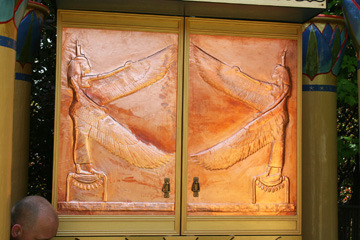
These doors are copper repoussé by the artist Lee Graham, also known as Dancing Raya.
Filed under: Goddess Isis, Modern Paganism Tagged: Aspects of Isis, Egyptian magic, Goddess worship, Isis, Isis Magic, Isis Rituals, Isis worship today, The Goddess and modern women








May 18, 2013
Isis Magic is Now Available!
Oh my ever-lovin’ Goddess—Isis Magic is finally back in print and now available for online purchase. Just click on the sidebar and you’ll be magically transported to the site where you can purchase it. This is the Abiegnus House website, our small (perhaps micro would be a more apt description) publishing company. At present, we are only PayPal enabled, but you don’t have to have a PayPal account to use the checkout, so no worries.
I’m excited to tell you abou t some of the new things in this 10th Anniversary Edition:

As in the previous edition, the first part of Isis Magic helps you discover the many faces of Isis as seen through the eyes of Her devotees, from ancient Egypt and the Mediterranean world to the secret societies of the past and today’s Neo-Pagan groups and individuals. The second part offers a spiritual path that guides you in creating or deepening your own relationship with this most powerful and magical of living Goddesses.
This new Abiegnus House edition of Isis Magic offers even more, including:
• New meditations and exercises
• New rituals for every stage of your relationship with Isis
• A more powerful Opening of the Ways rite for the Votary
• More graceful Egyptian language for the Star of Isis ritual
• A new same-sex wedding ceremony
• A new rite of ascension for the Magician of Isis
• A major new initiatory rite, The Twelve Hours of the Night, for the Prophetess or Prophet of Isis
• Less formal, easier to understand ritual instructions
• New illustrations to help demonstrate concepts and new photographs to enjoy
• And for the scholars among us, footnotes rather than endnotes—to make your own further researches easier
You’ll find more information on the site as well, and even that will be expanded as time goes by.
Please do me a huge favor and forward this to anyone you think might be interested. And please tell them to get their orders in early. We could only afford to print 2500 copies for this first foray. So if you or friends want a copy, please do order soon.
I truly believe this new edition is better than ever. I hope you enjoy it…and may it help bring you ever closer to Isis.
Filed under: Goddess Isis








May 4, 2013
And Her Temples Rise Once More
To follow up on last week’s post—and by way of tangible proof that Her temples still live—I’d like to share with you the Temple of Isis in my backyard. It is named the House of the Lotuses, Per Sushenu, or the Lotus Temple. It was built for an Isis Festival in 2010 and reconstructed in our backyard following the festival since nobody could bear to see it destroyed. Incidentally, that festival is the same one for which I originally instituted this blog. As you can see, both blog and temple are still going strong.
The Temple of Isis lives in so many of our hearts. I am extremely fortunate in that I also have one living in my backyard. With that, here’s a tour of the House of the Lotuses:

The House of the Lotuses; it is about the size of a large gazebo, which is how we explain it to the neighbors: it’s an Egyptian gazebo!

The temple is decorated with glass lotuses, each cut by hand and cemented in place.

One of two lotus planters in front of the temple; this year, we have speedwell growing, in other years, it has been grasses

The roof of the temple is painted as Mother Nuet’s starry belly

There are eight large outer pillars and two smaller inner pillars supporting the temple; they are shiny because they were urethaned to withstand the Pacific Northwest rain; yes, I had to have my coffee with me!

A single lotus pillar; that bit of purple you see behind it, is the grape arbor of Dionysos

Another shot of the lotus pillars, Nuet’s sky, and the glass decoration on the top of the temple

The inner shrine area is illuminated with the rays of The Radiant One and decorated with delicate purple and white lotuses

The copper repousé shrine doors slide open so that the winged Isises guard the sacred image within

The Radiant Isis in Her shrine

A side view of the House of Lotuses
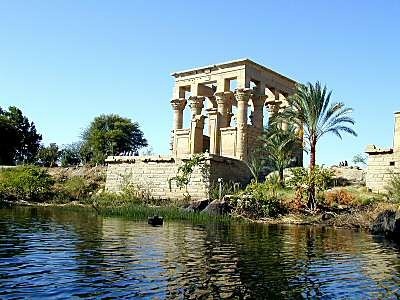
Philae-Portland, Portland-Philae. Coincidence? I think not.
Filed under: Goddess Isis, Modern Paganism Tagged: Blue Lotus, Goddess Isis, Modern Goddess Worship, Temple of Isis








April 27, 2013
The Setting & Rising of the Temple of Isis
The forced closing of the Temple of Isis at Philae during the reign of the Byzantine Christian Emperor Justinian (527-565 CE) is generally considered to mark the end of Egyptian religion.
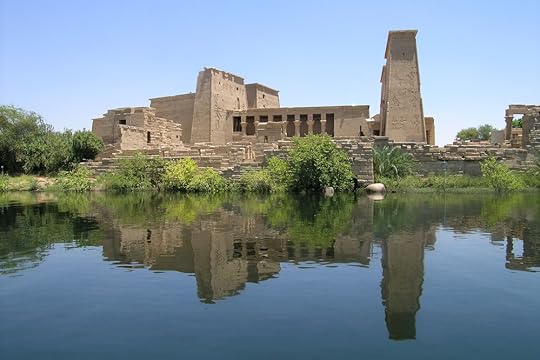
The Temple of Isis (formerly on Philae, now on Agilkia); photo by Ivan Marcialis from Quartucciu, Italy and used under Wiki Creative Commons usage guidelines
Yet you and I are evidence that, though Isis’ Egyptian temples could no longer be places of worship, Her spiritual temples could never really be closed—and today flourish once more, not only in our hearts, but physically as well, in many of our homes. It is an interesting coincidence that the UNESCO project to move Isis’ flooded temple from Philae to the higher ground of the island of Agilkia began in the 1960s, a period that also marked the rise of second-wave feminism and the most recent upwelling of Goddess religion.
Or perhaps, it’s more of a synchronicity than a coincidence.
At any rate, today’s story is about the last days of ancient Philae, the beautiful Ptolemaic-built temple of Isis.
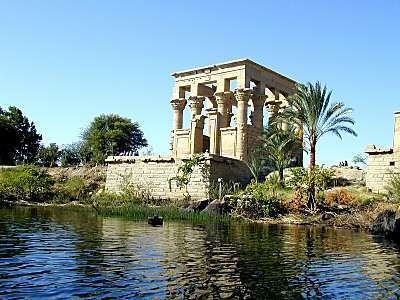
The lovely Philae kiosk of the Roman Emperor Trajan in which the emperor is shown making offering to Isis and Osiris
Beginning in 391 CE, a series of edicts by the emperor Theodosius I made Pagan worship increasingly illegal. By 438 CE, no one was allowed to even “wander through the temples.”
Yet Philae, far down the Nile in southern Egypt, remained an outpost of the old religion. The biographer of the Neoplatonist philosopher Proclus (449-468 CE) wrote that Proclus made a point of worshipping the old Deities and specifically includes “the Isis still worshipped at Philae” among Them. Hellenes in Athens, a city that maintained a large Pagan population through the middle of the 5th century CE, made pilgrimage to Philae, which is attested by graffiti at the site. An Egyptian priesthood seems to have persisted at Philae until at least the time of the closing of the temple.
Southern African tribes also continued to honor Isis. There are two that stand out in history as Isis worshippers: the Nobades from Nubia and the Blemmyes from the eastern desert of Egypt. They repeatedly fought against the Romans in Egypt. Eventually, the Romans paid them off to stop the fighting, enlisted them to police the southern border and and gave them access to the temple of Philae so that they could continue to worship their Goddess. A fragment from the historian Priscus (late 5th century CE) tells us that an “ancient custom” was observed at Philae, whereby the Blemmyes
were to have the right to cross unhindered to the temple of Isis, while the Egyptians had the care of the river boat in which the statue of the goddess [Isis, of course] was placed and ferried across the river. At a fixed time the barbarians take the wooden statue across to their own land and, when they have taken oracles from it, return it safely to the island.

An Orientalist imagining of a procession in honor of Isis; art by Frederick Arthur Bridgeman
An interesting inscription from 373 CE notes that “the barque of Isis” was “far away for two years” but had finally returned. The barque was surely the sacred boat that took the image of the Goddess to and from the homeland of the Blemmyes. Historians have conjectured that some sort of political upheaval may have kept the tribe from returning the sacred image during this time. Several prayer requests to Isis have been found from this same period; more evidence of a living cult.
In 439 CE, shortly after the 438 CE publication of the Theodosian Code forbidding Pagan worship, an inscription from Philae noted that a certain Prophet of Isis made his obeisance before Isis “in the year named an abominable command.” The inscription is not entirely clear, but it seems to be decrying that a priest’s service to Isis should be banned by the “abominable command” of Theodosius.
And yet, the worship of the Goddess continued at Philae. An inscription of 452 or 453 CE from a priest says that he, along with his brother, came to Philae and “performed his function” there. Another inscription from 456 or 457 CE makes note of a sacred feast that was held at Philae, possibly in connection with the ongoing lending of the statue of Isis to the Blemmyes.

Christian symbols carved on the walls of the Philae temple
Around 425 CE, we begin to see Christian activity on Philae, coexisting with the Isis temple. Some years after this, we have a petition from a Christian bishop complaining about the marauding Nobades and Blemmyes. Eventually, under the Roman Emperor Marcion (450 to 457 CE), the treaty with the tribes that gave them access to the image of Isis would be negotiated, at least temporarily solving the problem.
Not long thereafter, we begin to see Christian graffiti scratched on the Temple of Isis. Sigh. Between 535 and 537 during Justinian’s reign, the Temple of Isis, as well as the rest of the temples on Philae, were officially closed and supposedly “pulled down” by a general Narses who jailed the priests and sent the sacred images back to Byzantium. There is a terrible story from the 6th-century Life of Aaron, that tells how the first bishop of Philae, one Macedonius, entered the temples at Philae and slaughtered “the living falcon worshipped there by the pagans.”
But even that was not yet the end for Egyptian religion and the worship of Isis at Philae. In a papyrus known as the Papyrus Cairo Maspero (usually abbreviated as P. Cair. Masp.) and dated to about 567 CE, we have a petition written to the governor of the province in which Philae was located. We even know the scribe who wrote it, Dioscorus, who was also a poet. (That makes sense, doesn’t it? A writer making a living as a scribe.)
The petitioners complain about a man they nicknamed Omophagos (Raw Eater) who has been leading some of the Blemmyes away from the true path by renewing the temples and setting up shrines “with demons and wooden statues.” Omophagos was said to have “set aside the taught Christian worship and religion” and with his band of Blemmyes was ravaging the countryside and making it impossible to collect taxes (which is clearly the argument the petitioners think will have the most impact on the governor.
Yet we don’t know the governor’s answer, so we don’t know the outcome of the story.
What are we to make of this? Should we consider Omophagos some sort of Pagan Robin Hood? Or was he merely a brigand who also happened to be Pagan?
While we cannot know the full story, we can know that the worship of the Great Goddess Isis retained its importance for Her devotees long, long after it was officially forbidden. In part because of this tenacity, there is still a great deal of magic to be found in the Temple of Isis at Philae, its beautiful buildings now reconstructed on the island of Agilkia. It is a holy place not only for the worship of the Goddess that was conducted there, but as a demonstration of the ongoing strength of that worship and the need of humanity to know its Divine Mother.
Filed under: Goddess Isis Tagged: Goddess Isis, Isis & Philae, The last Pagan temple








April 20, 2013
Isis & Magic; Magic & Isis
Great of Magic. The Enchantress. Lady of Sacred Magic. What does it mean that Isis bears these (and so many more) titles having to do with magic? What is magic?
If you’ve been reading this blog, you already know that “magic” isn’t what the ancient Egyptians would have said. They would have said heka. But the same question applies: what the heck is heka? (Pronunciation note: I usually say “HAY-kah,” because I think it sounds better than heck-kah. Coptic shows the word as hik. If Coptic retained the vowel correctly, then the Egyptians might have said hik-kah, which is worse, since it sounds—in my head anyway—like hiccup. So for me, hay-kah it is.)
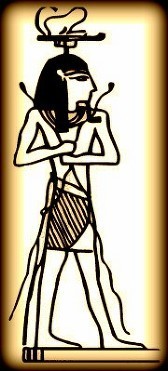
Heka, the God Magic
Unfortunately, we can’t ask any ancient priestesses or priests of the Goddess of Magic what they meant by magic. So we have to to look to some of the scholars who have studied it. One of the first things that they—and we—see is that in Egypt, heka was not at all supernatural, that is above nature. Indeed, Heka (the God) and heka (the concept) were the very foundation of the natural world. In at least one myth, the God Heka, Magic personified, is the Being first made by the Creator and Heka’s power in every Deity and every thing that comes after Him. The Deities are the most potent wielders of heka, though humanity has its portion, given to us “to ward off the blow of events,” according to one of the Wisdom Texts.
The reason we translate heka as magic is because that’s how the ancient Greeks, who were actually in contact with the ancient Egyptians, translated it: mageia. A person “who does heka” was translated by the Greeks as a magos (masc.) or maga (fem.). On the Egyptian priestly side of things, there were Servants of the God Heka, who were, no doubt, considered powerful magicians. Interestingly, an Egyptian stele listing the names and titles of physicians has both sunu, “doctors” and hem-netjer Heka, “Servants of the God Heka.”
So here magic meets science, as it usually does around thoughtful magicians. It seems that the magicians of every age are anxious to explain magic with the science of their time. Everybody knows that it works (somehow); yet we have a need to explain to ourselves precisely how. In ancient Egypt, heka and Heka are so intertwined that often no distinction seems to be made between them. This is sacred science, priestly science, and magic is a Divine, living, conscious “energy.” Egyptian magic has rather precise ritual forms. Surely these were the advanced scientific forms of their day, having been refined through many generations of experimentation.

A beautiful Isis working energy magic, by artist Bill Brouard. You can purchase it here.
In the Middle Ages, magic might be explained in demonic or satanic terms; the magician invoked devils to do his bidding; it was sort of an anti-priestly science of ritual names and actions. Alchemists blended spirituality with chemistry and explained both effects as revealing the Ways of Nature. And isn’t revealing the workings of nature what scientists do to this very day?
18th-century occultists preferred to use scientific-sounding explanations for magical effects: “magnetism” explained attractions between things as well as defined pathways for moving “life energy” or the “etheric medium.” In the late 19th and early 20th century, Aleister Crowley famously defined magic as “the Science and Art of causing Change to occur in conformity with Will” and “the Science of understanding oneself and one’s conditions. It is the Art of applying that understanding in action.” Psychology was a relatively new science at the time, you see.
[image error]
An image from one of the shrines of Tutankhamon; clearly an energy transfer from star to these Otherworld Beings
Many modern magicworkers speak of magic as “energy.” There are many types of energy we are just beginning to understand or do not yet understand, so why shouldn’t magical energy be one of these? Some “postmodern magicians” speak of magic in terms of information—as ones and zeros even—since that is the scientific paradigm of our day.
The truth is, I find value in just about all of these ideas about magic. Information magic gets along famously with Egyptian magic and its Words of Power (which is a translation of hekau; plural of heka). The as-yet-unexplained-energy theory of magic also works well with ancient Egyptian magic as there often seems to have been a physical component in Egyptian magic. Both the demon and Deity theories attribute consciousness to magic as was done in ancient Egypt with Heka. And how can our own psychology not play a part in magic?
As usual, my personal answer to a definition of magic is “all of the above.”
As devotees of Isis, the Goddess of Sacred Magic, we have a certain obligation to address magic in some way in our personal practice. This may be the magic of spiritual growth, the Great Work of Hermeticism. Healers might explore the connection between magic and medicine. We may find we have a talent for practical magic, the spellcasting magic that can help us get a job or find a parking spot.
Come to think of it, I haven’t been doing enough magic lately. Think I’ll try to remedy that this weekend…
Filed under: Goddess Isis Tagged: Isis and magic, Isis Magic, Isis the Magician, theories of magic








April 13, 2013
Isis, Lady of Books
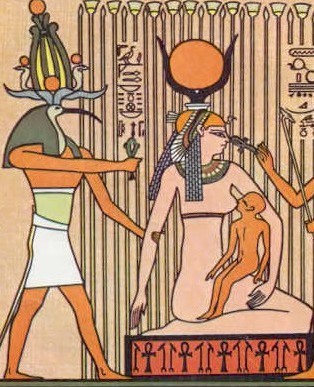
Thoth supporting Isis in the papyrus marsh
Books and words have the magic power of being able to transmit thoughts from one person to another and from one person to many—without those people ever having met each other face to face. This is a great magic indeed and the ancient Egyptians well knew it. That is why their greatest Divine Magicians, Thoth and Isis, both commanded Words of Power (Hekau) and through these powerful words, worked Their holy magic.
The magic inherent in words is only emphasized when we know that only a very small percentage, perhaps only 1%, of the people in ancient Egypt could read and write. Magician-priest/esses who “know their spells” were considered to have the God Heka Himself in them.
Egyptian books were kept in the temple Houses of Life, which we can think of as a library or perhaps even a research library. (Libraries might also be called Houses of Words.)
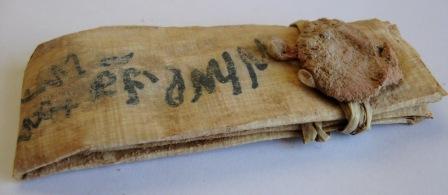
A sealed Egyptian papyrus text
The ritual formulae within the libraries were great mysteries that could even be regarded as “state secrets,” for magic was used in protection of the pharaoh and of the country. One of the most beautiful things I’ve read about the libraries is from Diodorus Siculus. He recorded that the temple library at the Ramesseum was designated as the Psyches Iatreion, the Healing Place of the Soul. I can attest that there have been many books that have healed my own soul.
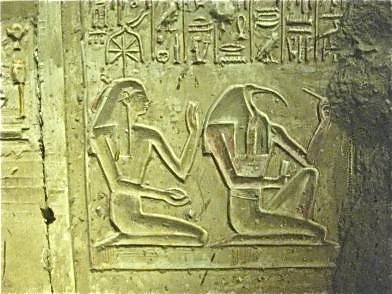
Thoth & Seshat
Of course, Thoth is the God most closely associated with books and writing. He is the Great Divine Scribe and Lord of Books. I have no doubt that when His scribes wrote, they were considered to be in the Godform of Thoth, or “to have the God Thoth in them.” Perhaps due to Their knowledge of Words of Power, both Thoth and Isis are Divinely wise. We frequently find Them together in one way or another. In the Egyptian myth of Horus’ poisoning by scorpion bite, Thoth brings His Words of Power to aid Isis in healing Horus. Isis was often assimilated with Seshat, the Goddess of Writing, Reading, Arithmetic, and Architecture, Who is sometimes considered the wife of Thoth. By the Late Period, Isis and Thoth were related in another way; He is said to be Her father in one of the spells in the magical papyri.

Egyptian papyrus growing in the marsh
With the importance of Egyptian books, the papyrus that was used to make the books was also a sacred thing. The marsh-loving papyrus was thought (like the lotus) to be the first plant to emerge from the primordial waters. It could also symbolize the primordial marsh from which all life emerged. The hieroglyph for papyrus meant “green” and, to the Egyptians, surrounded by the red land of the desert, green was synonymous with good. The papyrus hieroglyph was used with concepts like “flourish,” “joy,” and “youth” as well. A papyrus amulet served as a general good luck charm. When placed with a mummy, it was meant to keep the body supple and “green.” One of the Coffin Texts mentions that “reassembly” (for rebirth of the deceased) is carried out “by means of papyriform amulets.”
Isis is associated with the green powers of papyrus in Her role as the Goddess Who reassembles and renews Osiris and the deceased and with papyrus itself in Her role as Goddess of writing and sacred words. In Isis aretalogies from Kyme in Turkey and Maronea in Greece, Isis and Thoth are credited with being the creators of hieroglyphic and demotic letters (a later script form of hieroglyhs). The Cairo calendar calls Isis “Provider of the Book.” In the aretalogy from Oxyrhynchus in Egypt, Isis is praised for being skilled in writing and calculations. At Busiris, also in the delta, Isis was even called Djedet Weret, the Great Word. (In fact, this reputation followed the Goddess all the way into the Middle Ages when, as an ancestress and culture bearer, Isis was credited with teaching the Egyptians the letters of the alphabet and how to write.)
 As you may have guessed, I chose this topic of Isis as Lady of the Book in anticipation that Isis Magic will soon be available once more. We expect delivery of the books next week…and we are currently building the website from which you will be able to purchase them.
As you may have guessed, I chose this topic of Isis as Lady of the Book in anticipation that Isis Magic will soon be available once more. We expect delivery of the books next week…and we are currently building the website from which you will be able to purchase them.
Filed under: Goddess Isis Tagged: Isis and the Word, Isis and Thoth, Isis Magic








April 6, 2013
Women as Priestesses in Ancient Egypt

Priestess Merit, photo by Hilda H Photography
Our topic today? Sexism in egyptology.
Okay, it’s actually priestesses in ancient Egypt, but it was a bunch of sexist assumptions by previous generations of egyptologists that allowed the importance of priestesses to be overlooked or discounted and inspired me to choose this topic for the post.
What sort of sexist assumptions you say?
Many old-school egyptologists have assumed that women were not allowed to participate in the most holy—that is, most important—aspects of worship. They have assumed that the sacerdotal titles of high-status Egyptian women were simply honorary and the women did not actually perform the work of a priestess. Such assumptions are never made when it comes to Egyptian men with corresponding titles. Never. By translating the Egyptian term, Servant of the God—which was used of both men and women—as priest or priestess, the old gentlemen were allowing themselves a little mental sexism for, in their minds, a priestess was always of lower status than a priest because in their society women were of lower status than men. It was assumed that the religious involvement of women with priestly titles was not “professional” and when Egyptian religion became “more organized” in the New Kingdom, there was an effort to exclude women.
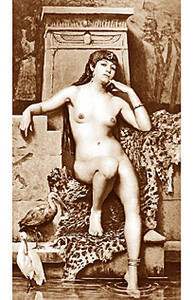
An early-photography fantasy of a languid Priestess of Isis
Sheldon Gosline, the author of a scholarly article I’m reading on this topic, believes this assumption is mainly based on Christian and Jewish exclusion of women from priestly activities rather than on any real evidence from Egypt. There has also been the assumption—less these days than it was, thank Goddess—that women’s roles in the temple were mainly sexual; that the female musicians were some sort of harem (because music is inherently sexual, you see) and that the God’s Wife, another priestessly title, was supposed to have sex with the priests of the temple who represented the God. Such assumptions were, no doubt, based on statements like this one from the Greek geographer Strabo, himself hailing from a supremely sexist culture. Says Strabo:
“To Zeus [Amun] they consecrate one of the most beautiful girls of the most illustrious family . . . She becomes a prostitute and has intercourse with whoever she wishes, until the purification of her body [menstruation] takes place.”

Queen Ahmose Nefertari, Hatshepsut’s grandmother and God’s Wife of Amun
(We are always hearing tales of temple prostitution, are we not? It’s just so…so…well, pagan.) In fact, there is no evidence of Egyptian temple prostitution or that priestesses were expected to have sex—sacred or otherwise—in the temple. The opposite is true; part of the negative confession was to profess that you had not had sex in a sacred place. (None of this is to say that sex had no place in ancient Egyptian religion and culture; it did, and an important place. But that’s a topic for another day.)
Thankfully, more modern egyptologists are taking a less biased view. So what’s the real story?
Due to the incomplete nature of the evidence, we can never be entirely certain. Yet we do have the opportunity to look at what evidence remains in a fresh way. When we do so, we notice that we have records of quite a large number of ancient Egyptian priestesses. These records come from all periods and regions of Egypt. We see that supposedly honorific titles were borne by some women who were not married to priests or who were married to men of lower rank. In other words, the woman’s status was her own and she did not derive it from her husband. From the fifth dynasty we have a record that shows that the sons and daughter of one noble family took turns being the Servant of the God of Hathor. The religious duties of the sister Servant of the God would have been the same as those of the brother Servant of the God or it would not have been possible to switch off like that. We also have records showing that lower-ranked priestesses and priests were paid exactly the same amount for their temple service, which must indicate the equal importance and likely equal duties the job entailed. We have evidence that the priestessly title of Meret, “Beloved,” may have been quite a high-ranking position. At least one Meret priestess was responsible for the financial security of the temple through care for its real estate and agricultural resources—a very important role and one that must have required a great deal of education.
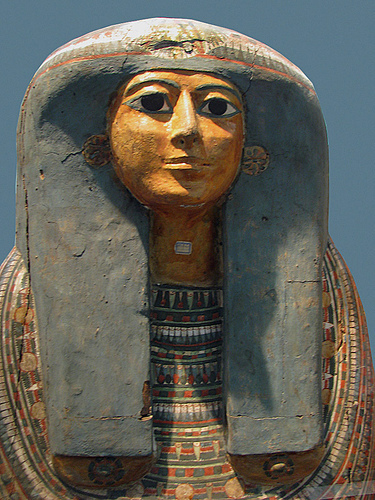
The sarcophagus of a Chantress of Amun
As Egypt came in contact with more sexist cultures, such as Greece, it may well be that some priestessly power eroded. This is, no doubt, why Hatshepsut’s grandmother revived the important title of God’s Wife and Hatshepsut later took it for herself. In later periods, we find many priestesses with the title of Chantress and may be tempted to dismiss it as a minor role, yet it may well be that we are undervaluing the vital role that music played in the worship of the Goddesses and Gods. Many of the women with this title were royal and noble. We have letters surviving from some of these Chantresses that indicate they wielded a great deal of power. The Great Chantress of Amun wrote to a military official sharply ordering him to supply rations for the workmen: “Don’t let [name of another official] complain to me again,” she writes. “Have them prepared for the people…” Women tended to prefer using their title of Chantress even over other prestigious titles they may have held, which surely indicates the title’s high status.
Like other Deities, Isis would have been served by Her priestesses. They would have made music and sung hymns for Her, presided over offerings, and perhaps even tended Her temple’s real estate holdings. In fact, by the New Kingdom, Isis as one of the Deities (the others are Amun, Montu, Mut, and Osiris) most commonly served by priestesses.
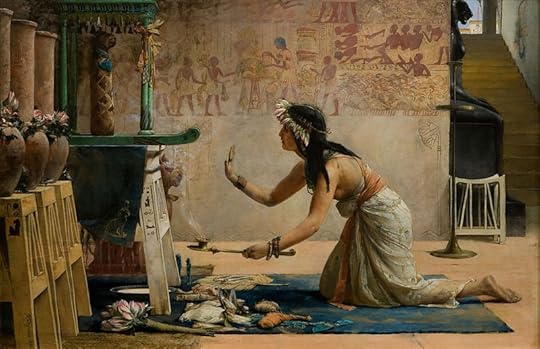
A lovely 19th century painting by John Weguelin of a priestess making offerings for the ka of a cat
Filed under: Goddess Isis Tagged: Egyptology, Priestesses, Status of Egyptian priestesses








March 30, 2013
Happy Resurrection Day
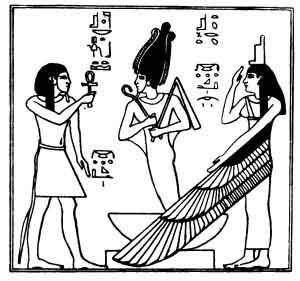
Osiris rising, protected by the wings of Isis
I am something of a crazy woman this weekend (which is decidedly different from a maenad) so I will try to get a post done later this week. But for now, let me rely on that old staple of columnists, the re-run. This one is about how Jesus and the Beloved of Isis, Osiris, have some things in common.
This is not one of those ‘Christianity is really just Paganism’ posts nor is it a Pagan rant about how the Christians appropriated our God. They didn’t have to. And they were really trying not to. Yet much of early Christian history takes place in…well…Egypt, so it would be very natural for newly minted Egyptian Christians to employ elements of their prior religion in the way they thought about their new one.
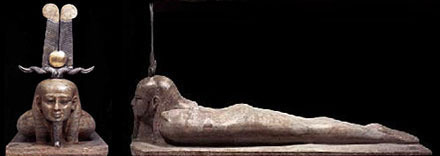
Before Osiris could rise, He had to roll over on His stomach as you see in this beautiful statue. I am so pleased that I got to see this statue in person as part of a traveling exhibition.
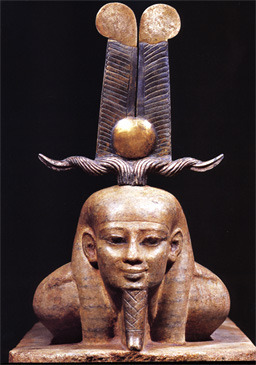
Here’s a close up of His serene and beautiful face.
Filed under: Goddess Isis Tagged: Osiris and Jesus, Resurrection








March 23, 2013
Spring Rites of Isis
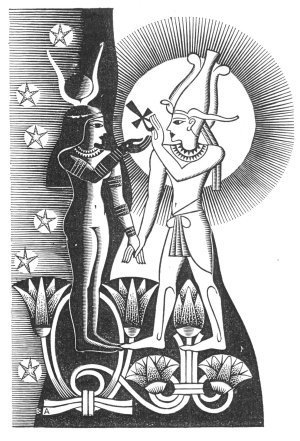
The uniting of Isis & Osiris; I don’t know whose art this is, if you do, please let me know
Plutarch, in his essay on Isis and Osiris, mentions an Egyptian festival that he says marked the beginning of spring and which was called The Entry of Osiris into the Moon. Here’s what he says:
Further, on the first day of the month of Phamenoth they hold a festival, which they call Entry of Osiris into the Moon, for it is the beginning of spring. Thus they locate the power of Osiris in the moon and say that Isis, as the creative principle, has intercourse with him. For this reason they also call the moon the mother of the world and they believe her nature to be both male and female since she is filled and made pregnant by the sun while she herself in turn projects and disseminates procreative elements in the air. (Plutarch, On Isis and Osiris, 43)
In his discussion of this passage, J. Gwyn Griffiths (have I mentioned he’s one of my favorite Egyptologists?) notes that there is no festival by that name in any known Egyptian calendar. Yet there are Egyptian texts from the temple at Denderah that show Osiris in a boat with Isis and Nephthys and explain that Osiris is entering into the Left Eye; and the Left Eye, as you may know, is an Egyptian designation for the moon. In the Denderah texts, spring is not mentioned, but Osiris is said to do His entering on the 15th of the month, that is, at the full moon. So in these texts, Osiris is seen as the sun as He enters into and unites with the full moon.
This also seems to be the case in what Plutarch writes. Osiris enters into the moon and Isis, the Creative Principle, unites with Him in sexual intercourse. Like the moon—the Mother of the World—Isis is filled and made pregnant by the sun, which has to be identified with Osiris. The moon is then both male and female for Isis and Osiris are united in it.
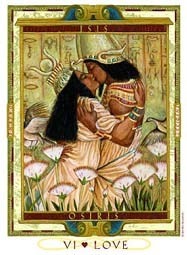
Isis & Osiris as lovers from Kris Waldherr’s Lovers Path Tarot; learn more about the deck here
To date, this is all I know about this ever-so-intriguing reference. But I very much like the idea of a spring sexual rite of Isis and Osiris and, in fact, this reference inspired the rite of sacred sexuality in Isis Magic. A rite of sacred sexuality makes a great deal of sense as a rite of spring—when everything else is waking up and having sex and getting fertile once again. Bunnies. Eggs. Flowers waving their genitalia in the spring air. You get it.
In another part of his essay, Plutarch mentions an Egyptian tradition that the confinement of Isis (while She is pregnant with Horus and awaiting His birth) was celebrated after the spring equinox. This actually could work if Isis becomes pregnant at the spring equinox and carries Horus until His birth at the winter solstice, a period of nine months—or by Egyptian lunar count, ten. One of the Isis aretalogies notes that Isis decreed that women should give birth in the tenth month.
I’m not quite sure how to place the death of Osiris in this scheme, for His death rites are generally celebrated after the autumnal equinox. In that case, He has approximately six months in the otherworld, which is perhaps sufficient time for Isis to use Her magic to raise Him so that, by the vernal equinox, He can “enter into the moon,” make love with Her, and beget Their Holy Child.

Isis & Osiris as lovers; detail of artwork by Sharon George; buy prints here
Just to be clear, no Egyptian tradition that I know of includes this particular seasonal timetable, yet I think it’s a fair conjecture and should be more than enough to inspire the appropriate rites of spring in Her devotees. Happy spring equinox…and may Isis and Osiris inspire and bless you in this season of growing light and life.
Filed under: Goddess Isis, Modern Paganism Tagged: Isis & Osiris, Isis Moon, Osiris Moon, Spring sacred sexuality








March 16, 2013
Isis and the Sistrum
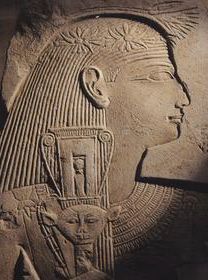
A priestess with the naos style of sistrum
In Isis Magic, one of the key elemental implements of the priestess of Isis is the sistrum. It is one of several types of ancient Egyptian rattles that were used in the worship of the Goddesses and Gods. But it isn’t simply a musical instrument; it is also a magical instrument.
As you may already suspect, sistrum is a Latin word. In turn, it derives from a Greek term for the Egyptian rattle: seistron ”that which is shaken.” The Egyptian terms are a bit more interesting. One of them is onomatopoeic, that is, the word sounds like the thing it represents. That one is sesheshet (say it out loud and you’ll see what I mean). The other is sekhem. And that one is quite interesting, for it means “power,” as in the name of the Goddess Sekhmet, the Powerful One. It is, of course, among the names of Isis as well.
The sistrum is an instrument of power. Even better, the term for “to play the sistrum” also derives from the sekhem root, so when you’re playing the sistrum, you’re “doing power.” That’s why the sistrum is the elemental Fire implement of the priestess or priest in the House of Isis.
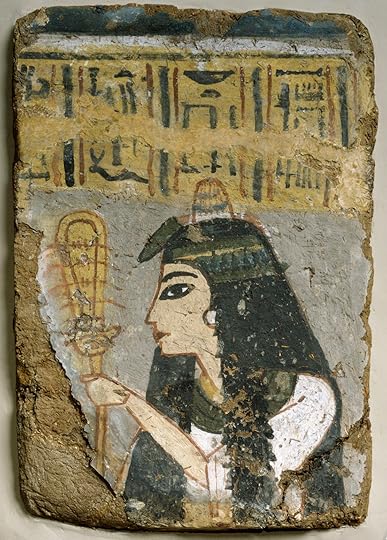
A priestess with the hoop sistrum
Plutarch seems to be echoing the true Egyptian tradition when he explains in his essay “On Isis & Osiris”:
The sistrum also makes it clear that all things in existence need to be shaken, or rattled about, and never to cease from motion but, as it were, to be waked up and agitated when they grow drowsy and torpid. They say that they avert and repel Typhon by means of the sistrums, indicating thereby that when destruction constricts and checks Nature, generation releases and arouses it by means of motion. (Plutarch, Moralia, Book 5, “On Isis & Osiris,” section 63)
The vibration of the rattling sistrum is as the constant vibration of the atoms that make up all things and the activity of all living things.
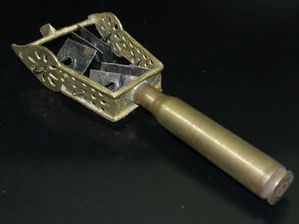
The bullet-casing sistrum; mine used to look just like this
Like many modern priestesses and priests of Isis, I have a collection of sistra (which is the plural of sistrum), including both handmade and purchased versions. Since the Coptic and Ethiopian Christian churches today still use sistra, you can actually purchase sistra that flow from the ancient Egyptian religious tradition. Naturally, I wanted to add one to my collection. So I ordered an inexpensive one online and when it came, it was, as expected, not super-high quality, but kinda sweet…except for the fact that the handle appeared to have been made out of ammunition casing. Eeewww. But the rattle sounded wonderful, nice and tinkly. I purified the sistrum and began using it.
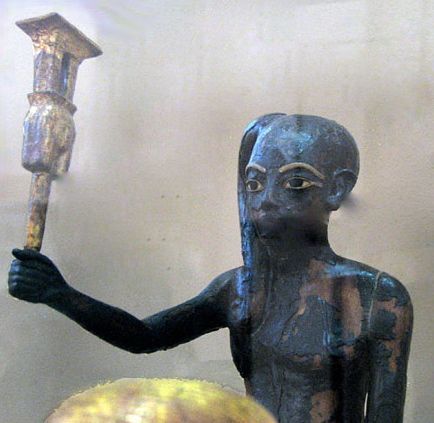
Ihy the Sistrum Player, son of Hathor
Now here’s the part I like. Not too long after that—with no hard use of any kind—I picked up the sistrum one day to discover that the bullet-casing handle had split near where it was joined to the head of the sistrum. While I was disappointed that my new sistrum had broken, I was also somewhat relieved. Happily, I know artists—and an artist friend replaced the handle for me with copper tubing. My repristinated copper and brass Coptic sistrum has been rattling up power for Isis ever since.
In ancient Egypt, while the sistrum was used in the musical worship of all Egyptian Deities, it was especially associated with the worship of the Great Goddesses Hathor, Bast, and Isis. Generally, more priestesses than priests played the sistrum. Yet the archetypal sistrum player is Hathor’s son, Ihy, often called simply the Sistrum Player.
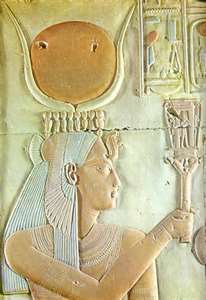
Isis with a naos sistrum from Abydos
The creation of the sistrum is said to have developed from the polite habit of rattling the papyrus stalks before entering into the papyrus marshes. The marshes, you see, were often the dwelling places of fierce Wild Cow Goddesses, such as Hathor, and poisonous Cobra Goddesses, such as Wadjet. It was considered the wiser course of action to let Them know you were coming. (Never sneak up on a Goddess; all the myths tell us so.)
If we think of it as a polite knock on the door before coming into the presence of the Goddess, we can consider the rattling of the sistrum as an Opening of the Ways from the mundane to the sacred. It can also be used to stir up energy, in ourselves or our temple space, as well as to add emphasis and power to certain parts of a ritual. Softer rattling can be used meditatively and to bring down and sustain energy as the ancients did when they used it to “pacify” an angry Deity.
The sistrum became inextricably tied to Isis when Her worship spread into Greece and Rome. In fact, it was so commonly associated with Her in Rome that when ancient Romans saw a sistrum, they immediately thought of Isis and no one else. Even as late as the 4th century CE, Maurus Servius Honoratus, a grammarian with the contemporary reputation of being the most learned man of his generation, noted that
Isis is the genius [the spirit] of the Nile, who by the movement of her sistrum, which she carries in her right hand, signifies the access and recess (or the rising and falling) of the Nile… (Servius, Observations on the Aeneid, 1.8)

A naos sistrum now in the museum in Athens

A hoop sistrum, now in the Louvre
There were two types of ancient sistra, which we know as the naos sistrum and the hoop sistrum. In a naos sistrum, the top of the rattle is shaped like a small shrine (naos in Greek); in a hoop sistrum, the top is an elongated hoop. Holes were made in the sides of the naos or hoop and metal rods were inserted horizontally so that when the sistrum was shaken, the rods rattled in the holes. Sometimes additional pieces of metal were pierced and strung on the rods to amplify the sound. (Many modern sistra have this feature.)
If you’d like to Do Power for Isis, you may purchase a variety of ready made sistra. DeTraci Regula’s Isiscraft Catalog offers a number of lovely ones. You can find versions of sistra in music stores that specialize in ethic instruments. You can also order the Coptic ones online (but they will probably come with the bullet-casing handles). And, of course, you can also make your own.
An Isis devotee of my acquaintance made some wonderful small sistra by splitting a piece of bamboo (about 1/4 inch in diameter) 2/3s of the way down. She glued ribbon around the unsplit part to keep the sistrum from splitting all the way and to create a handle. Then she glued a small piece of wood between the split

A bottle cap-type sistrum
bamboo as a wedge to hold the two sides apart, forming a “Y.” Finally, she strung flattened and pierced bottle caps on wire and attached the wire to both sides of the split bamboo. While I have sistra in my collection on which I’ve spent quite a bit of money, these homemade ones remain some of my favorites.
If you have made your own sistrum, I’d love to hear about it.
Filed under: Goddess Isis Tagged: Egyptian magic, Goddess worship, Isis, Isis Magic, Isis worship today, Sistrum, Sistrum & Isis, The Goddess, Who is Isis?












